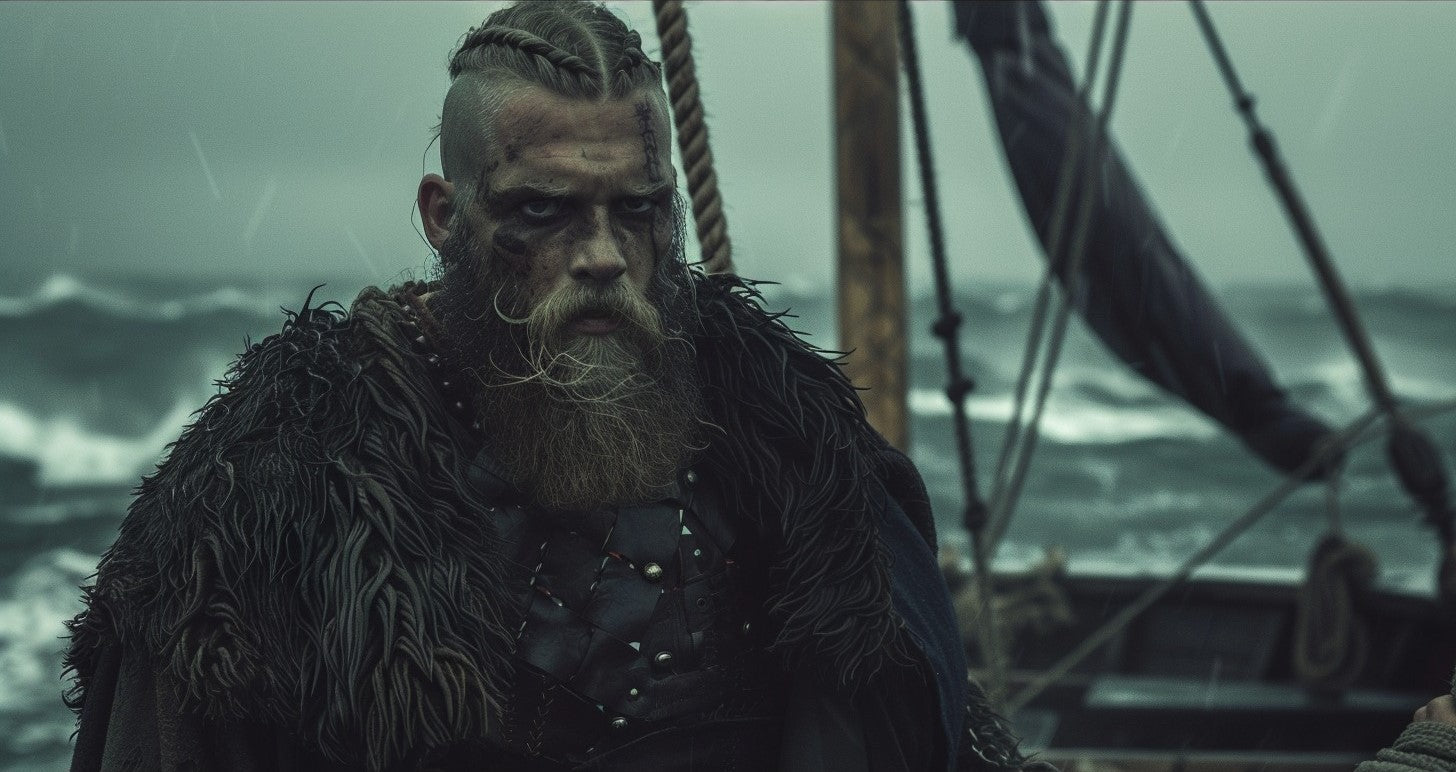
Erik the Red: The Legendary Viking Explorer Who Founded Greenland
Growing up in Iceland, Erik was immersed in the Viking culture of seafaring and exploration. The harsh landscape and limited resources of Iceland fostered a spirit of resilience and adaptability among its inhabitants, traits that would serve Erik well in his future endeavors. As a young man, Erik honed his skills in navigation, shipbuilding, and combat, all essential abilities for a Viking of his time.
Exile from Iceland and the Discovery of Greenland

Southern Greenland
Erik's life took a dramatic turn when he found himself embroiled in a violent dispute with his neighbors in Iceland. This conflict resulted in several deaths, leading to Erik's banishment from Iceland for a period of three years. Rather than viewing this exile as a setback, Erik saw it as an opportunity for exploration and conquest.
In 982 CE, Erik set sail from Iceland with a small fleet of ships, venturing westward into uncharted waters. After a perilous journey across the North Atlantic, he sighted land—a vast, ice-covered island that would become his new home and legacy. Erik spent the next three years exploring the coastline of this new territory, identifying areas suitable for settlement.
Upon his return to Iceland in 985 CE, Erik began to promote his discovery with great enthusiasm. In a stroke of marketing genius, he named the land "Greenland", despite its predominantly icy landscape. This clever naming strategy was designed to attract potential settlers, promising them a land of opportunity and abundance.
The Settlement of Greenland

Erik's persuasive tactics proved successful, and in 986 CE, he led a fleet of 25 ships carrying around 500 settlers to establish the first Norse colonies in Greenland. Two primary settlements were founded: the Eastern Settlement (Eystribyggð) and the Western Settlement (Vestribyggð). These colonies were strategically located in the fjords of southwestern Greenland, where the climate was milder and the land more suitable for farming and grazing.
The settlers faced numerous challenges in their new home. The harsh climate and short growing seasons made agriculture difficult, while limited natural resources required careful management. Their isolation from European trade networks meant they had to be largely self-sufficient, and potential conflicts with indigenous Inuit populations added another layer of complexity to their situation. Despite these obstacles, Erik's leadership and the settlers' determination allowed the colonies to thrive initially. They established a society based on farming, hunting, and trading, with a particular focus on valuable commodities such as walrus ivory and polar bear pelts.
Erik's Family and Legacy

Erik the Red's influence extended beyond his own explorations through his children, who would go on to make significant contributions to Norse history and exploration. His son, Leif Erikson, became even more famous than his father, credited with being the first European to set foot in North America, nearly 500 years before Christopher Columbus, thanks to the help of Bjarni Herjolfsson.
Erik's daughter, Freydis Eiriksdottir, was known for her fierce personality and is said to have participated in expeditions to Vinland (North America). His other sons, Thorvald and Thorstein, also played roles in the exploration of the New World, though their ventures were less successful than Leif's. The accomplishments of Erik's children further cemented his family's place in the annals of Norse exploration and discovery.
The Decline of Norse Greenland

While Erik the Red's initial settlement of Greenland was successful, the Norse colonies faced increasing challenges over the centuries. The onset of the Little Ice Age made agriculture and livestock farming increasingly difficult, forcing the settlers to rely more heavily on hunting and fishing. Changes in European demand for Greenlandic exports, particularly walrus ivory, diminished the colonies' economic viability, making it harder for them to obtain necessary goods from Europe.
Cultural inflexibility also played a role in the decline. The Norse settlers struggled to fully adapt their practices to Greenland's unique environment, often clinging to European farming methods ill-suited to the Arctic climate. Additionally, reduced contact with Europe led to a lack of new technologies and ideas reaching the settlements, further isolating them from the broader Norse world.
By the 15th century, the Norse presence in Greenland had come to an end, with the last known written record of the settlers dating to 1408. However, the impact of Erik the Red's bold venture would live on in Norse sagas and historical records, serving as a testament to the Viking spirit of exploration and resilience.
Erik the Red's Place in History

Statue of Erik the Red in Qassiarsuk, Greenland, with Narsarsuaq in the background.
Erik the Red's exploration and settlement of Greenland represent a significant chapter in the history of Norse expansion and discovery. His founding of the first European settlement in Greenland opened up a new frontier for Norse civilization, establishing a presence in the North Atlantic that would last for centuries. This achievement paved the way for further Norse exploration of North America, including his son Leif's famous voyage to Vinland.
Beyond his tangible accomplishments, Erik's adventures contributed to the rich tradition of Norse sagas and storytelling. His life story, filled with conflict, exile, and daring exploration, provided ample material for the oral histories that would later be recorded in medieval Icelandic manuscripts. These sagas have preserved Erik's legacy and continue to captivate readers and scholars to this day.
Erik's story embodies the Viking spirit of adventure, resilience, and innovation. His willingness to venture into unknown territories and his ability to lead others in the face of daunting challenges have secured his place as one of the most renowned figures in Norse history. His legacy serves as an inspiration to explorers and adventurers of all eras, reminding us of the human capacity to push beyond known boundaries and establish new frontiers.
Conclusion

Erik the Red's life and explorations continue to captivate historians and the public alike. His discovery and settlement of Greenland marked a significant expansion of Norse influence and set the stage for further explorations of the North Atlantic and beyond. While the Norse colonies in Greenland ultimately did not endure, their establishment represents a remarkable achievement in the annals of human exploration and settlement.
Erik's legacy serves as a testament to the human spirit of adventure and the capacity to adapt to even the most challenging environments. His story reminds us of the complexities of colonization and the delicate balance between human ambition and environmental realities. As we continue to explore our world and push the boundaries of human habitation, the story of Erik the Red remains an inspiring example of courage, leadership, and the enduring impact one individual can have on the course of history.
In reflecting on Erik the Red's life, we are reminded of the importance of adaptability, resourcefulness, and vision in the face of adversity. His journey from exiled troublemaker to founder of a new Norse colony demonstrates the potential for personal growth and transformation. Moreover, the eventual fate of the Greenland settlements serves as a cautionary tale about the need for sustainable practices and cultural flexibility in new environments.
As we face modern challenges of climate change and resource management, the story of Erik the Red and the Norse settlements in Greenland offers valuable lessons. It underscores the importance of understanding and respecting the environments we inhabit, and the need for innovation and adaptability in the face of changing conditions. Erik's legacy, therefore, is not just one of bold exploration, but also a reminder of the complex relationship between human societies and the natural world.
FAQs
- Was Erik the Red really the first to discover Greenland?
While Erik is credited with the European discovery of Greenland, archaeological evidence suggests that indigenous Paleo-Eskimo people had inhabited parts of Greenland long before Erik's arrival.
- How long did the Norse settlements in Greenland last?
The Norse settlements in Greenland lasted for about 500 years, from the late 10th century until the mid-15th century. The reasons for their disappearance are still debated by historians.
- Did Erik the Red ever visit North America?
No, Erik himself never made it to North America. However, his son Leif Erikson is believed to have reached the shores of North America around the year 1000 CE.
- Why was Erik called "the Red"?
Erik got his nickname "the Red" due to his red hair and beard, as well as his fiery temper. It wasn't uncommon for Vikings to have descriptive nicknames.
- How accurate is our knowledge of Erik the Red's life?
Much of what we know about Erik comes from Norse sagas, which were written down centuries after the events they describe. While these sagas provide valuable information, they also mix historical facts with legendary elements, so historians often debate the accuracy of specific details.
References
"Southern Greenland" by NASA Goddard Photo and Video is licensed under CC BY 2.0.
"Erik the Red" by aleph78 is licensed under CC BY-NC-ND 2.0.
Statue of Erik the Red in Qassiarsuk by Rüdiger Wenzel is licensed under CC BY-SA 3.0








